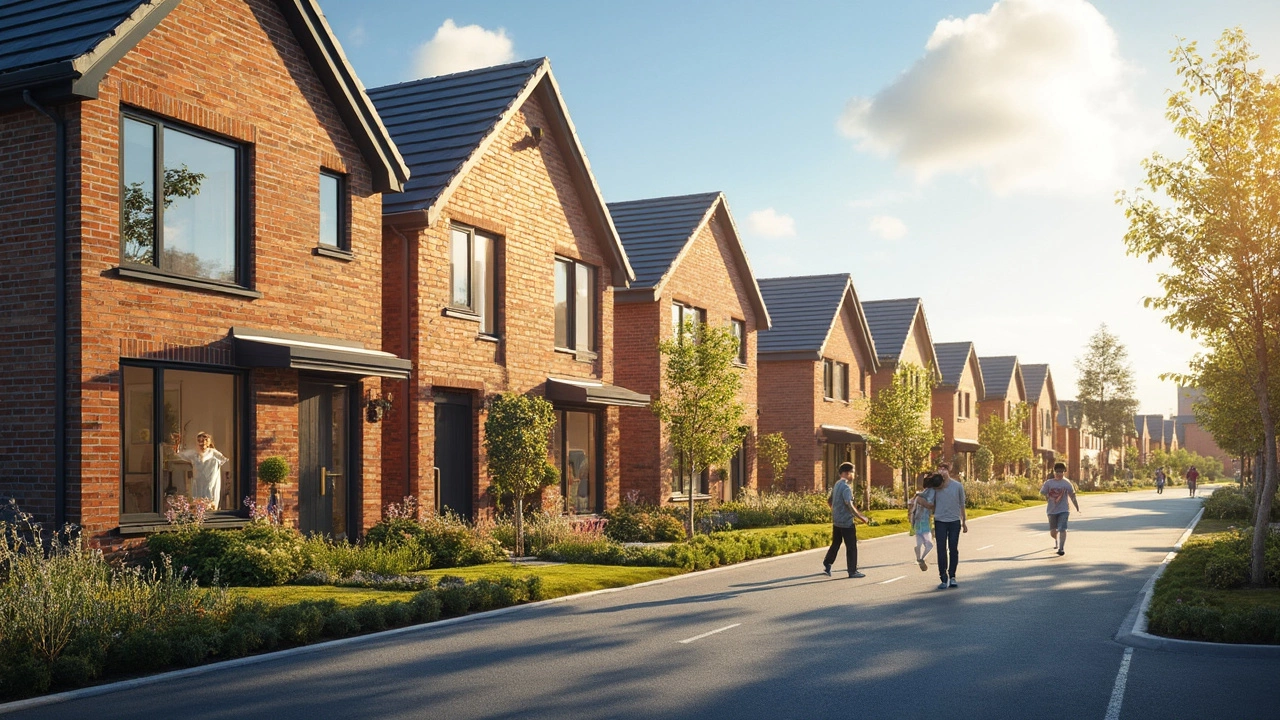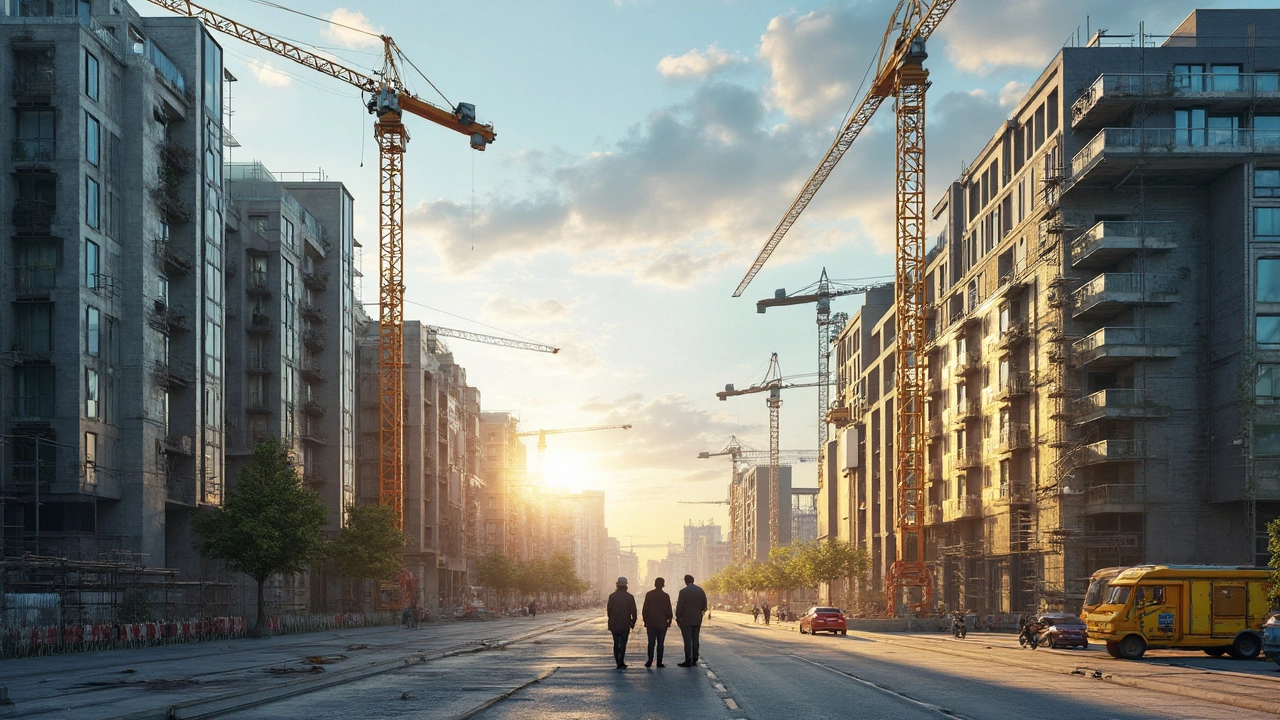So, you're curious about new builds, right? A new build, in simple terms, is a property that’s freshly constructed and has never had anyone living in it before. If you’ve ever driven by a construction site or a brand-new housing development, you’ve probably seen new builds in action.
These properties are popping up everywhere, forming the backbone of modern housing. They're like a blank canvas, waiting for someone to make them a home. It's not just about houses. New builds can be apartment blocks, stand-alone homes, or even modern commercial spaces.
Why do people go for new builds? Well, they come with all the latest conveniences, energy-efficient designs, and often, a warranty to give you peace of mind. Plus, they can be customized to a degree, depending on where you buy and who the developer is. But, like with everything, it’s not all sunshine and rainbows. Costs, timelines, and location are things you’ll want to consider.
What Are New Builds?
New builds are all about fresh starts. But what exactly makes a new build different from other properties? Well, it really comes down to the fact that these are brand-new properties. They haven't been owned or lived in by anyone before. It's like getting a car with zero miles on the odometer.
You’ll often find new builds springing up in modern subdivisions or urban developments. They range from stylish apartments to spacious houses. One of the main attractions is that they’re built with the latest designs and standards in mind, making them super appealing to those who crave modern living.
Types of New Builds
We can break down new builds into a few categories. There's the single-family home, which you’ve probably seen in quieter neighborhoods. Then there are townhouses, which offer a bit of communal living. And let's not forget those shiny new apartments, popping up like mushrooms in cities everywhere.
Why Choose New Builds?
There are loads of reasons people are drawn to new builds. First off, they’re energy-efficient. Builders pack them with top-notch insulation and modern heating systems. Plus, there’s less maintenance to worry about since everything from the roof to the wiring is brand new.
Property development on a larger scale allows for these homes to be more than just buildings; they're often part of master-planned communities with parks, shops, and schools nearby. The neighborhood gets built alongside the houses, giving a sense of a ready-made community.
Interesting Facts
| Aspect | Details |
|---|---|
| Energy Efficiency | Recent studies show that new builds use about 25% less energy than older homes. This means savings on your bills and a smaller carbon footprint. |
| Customization | While not as flexible as building your own home from scratch, many developers offer choices for different fixtures, finishes, and layouts. |
And remember, with a new build, you're often buying more than just a property. You're buying into a vision for the future, where convenience, community, and comfort all meet.
Benefits of Choosing New Builds
Picking a new build might sound like a big leap, but it comes with a bunch of perks that can make it really worthwhile. First up, you get modern features. From energy-efficient appliances to the latest techy touches like smart thermostats, new builds are usually created with today's lifestyle and eco-friendly standards in mind. Saving on energy bills and reducing your carbon footprint? That’s a win-win.
Modern Design and Customization
Another plus is the ability to customize. If you have the chance to get in early with the developers, you might be able to pick out finishes, fixtures, and sometimes even the layout of your new home. It’s a chance to tailor your property before you've even moved in, making it truly yours.
Warranty Peace of Mind
Worried about repairs? New builds often come with a warranty that covers structural defects and faults for the first few years. This safety net can mean fewer maintenance issues initially, giving you greater peace of mind.
The Financial Incentives
Don't forget the financial incentives! Buying a new build could mean access to government schemes or developer deals, especially for first-time buyers. This can make your dream home more affordable than you might think.
Community Vibe
Many new build developments also mean moving into a brand-new community. This often comes with its perks, including access to new schools, amenities, and public transport options, all thoughtfully planned from the ground up.
| New Build Aspect | Details |
|---|---|
| Energy Efficiency | Up to 20% savings on utilities |
| Warranty | Typically 10-year structural warranty |
| Customization | Options generally available with early purchase |
These benefits really highlight why new builds are so enticing, providing not just a place to live, but a place that works better for you from day one.

Things to Consider
Before diving into a new build, there are a few practical things you should mull over. It’s not just about loving that fresh paint smell or the shiny new appliances. Here are some key points:
Location, Location, Location
Sure, the property itself is important, but where it's located is just as crucial. Is it close to amenities like grocery stores, schools, and public transport? You wouldn’t want to spend half your life stuck in traffic just to grab a quart of milk.
Timing and Delays
Construction timelines can be unpredictable. Weather, supply chain issues, or worker availability can all push back a move-in date. While builders will give you an expected completion date, it's smart to have some wiggle room in your plans.
Cost Consideration
New builds can often have hidden costs. You usually pay a premium for being the first owner. Also, factor in things like landscaping or additional customization. Make sure you’re clear on what's included in the price and what isn't.
Builder Reputation
Not all builders are created equal. Research the developer's past projects. Were they completed on time? Was there a lot of post-handover maintenance needed? Reading reviews or even talking to previous clients can save you headaches down the line.
Long-Term Value
Finally, think about the future. New developments can sometimes lose value if they become surrounded by even newer builds. Consider the investment potential. Will this property still be attractive to others in a decade’s time?
| Consideration | Impact |
|---|---|
| Location | Accessibility to amenities |
| Delays | Altered moving plans |
| Costs | Additional financial planning |
| Reputation | Trust and quality assurance |
| Value | Future resale potential |
The Buying Process
Buying a new build can be different from snagging a pre-owned home. First off, you're generally working with a developer rather than an individual seller, which can feel more structured but also a bit commercial.
Step 1: Financing Your Purchase
Before even setting foot on a property, make sure your financing is in order. Unlike traditional homes where a mortgage can be based on the market value, new builds often have different timelines. You might need a construction loan or a special type of mortgage, so chat with a mortgage advisor who knows the ropes of property development.
Step 2: Reservation
Once you're set with financing, the next step is often to reserve a plot or unit. This usually involves a fee to take the home off the market for a set period. It gives you time to get your paperwork sorted out. Keep in mind, this fee isn't usually refundable if you decide to back out.
Step 3: Customization and Upgrades
One of the cool things about new builds is that you often get to pick finishes or upgrades, like flooring and appliances. Developers usually offer a menu of options, making it feel a bit like ordering off a really expensive restaurant menu.
Step 4: Legal Stuff
Your lawyer or conveyancer will need to review contracts and dotted lines. Make sure they're experienced with new builds since these contracts can have clauses about construction delays and other fun surprises.
Step 5: Home Inspections and More
People often assume a new build doesn’t need a home inspection because it’s brand spanking new. Wrong! Getting an inspection done is key to make sure everything is done right, from the plumbing to the electrics. It’s also a chance to spot snags or things that need fixing before you move in.
Step 6: Completion and Move-In
Finally, the moment you’ve been waiting for: moving in. Once everything has been signed, sealed, and delivered, you'll get what's usually called a 'completion date' when you can pick up the keys and start turning your house into a home.
Understanding the buying process for new builds can make for a smoother ride, ensuring you're not caught off guard by any unexpected bumps. Happy house hunting!
